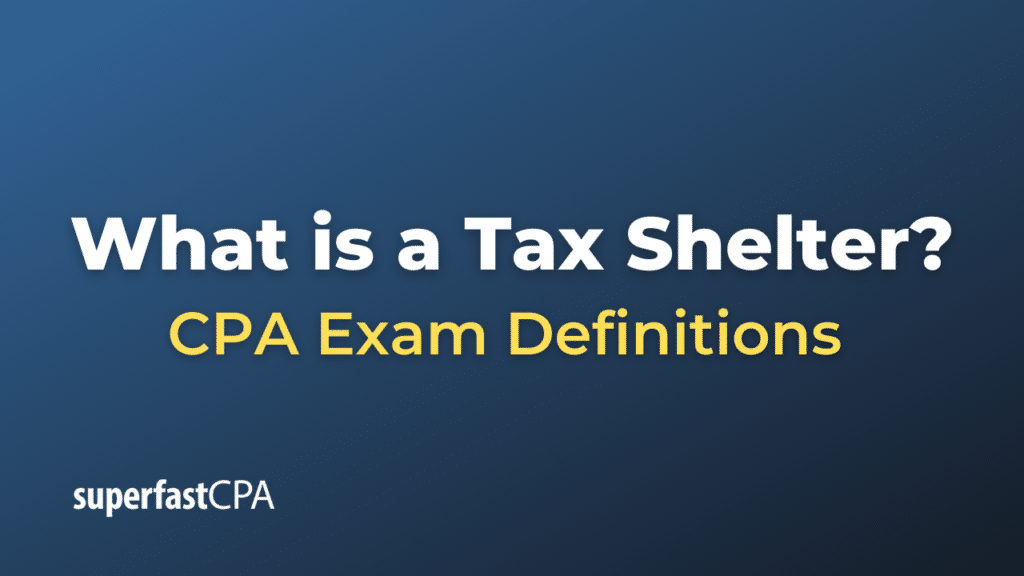Tax Shelter
A tax shelter refers to any method, strategy, or transaction that reduces taxable income, leading to a decrease in tax liabilities. Tax shelters can be either legal or illegal, depending on how they comply with the tax code.
Legal Tax Shelters: These are legitimate methods endorsed by the tax code to encourage specific activities or investments that have broader social or economic benefits. Examples include:
- Retirement Accounts: Contributions to certain retirement accounts (like 401(k)s, IRAs in the U.S.) may be deductible, effectively reducing taxable income for the year of the contribution.
- Real Estate Investments: Depreciation on real estate property can act as a tax shelter, providing a non-cash deduction against other types of income.
- Municipal Bonds: Interest earned on certain municipal bonds is often tax-exempt, making them a popular investment for those in higher tax brackets.
- Life Insurance and Annuities: Certain types of life insurance policies and annuities allow for tax-deferred growth of earnings.
- Charitable Contributions: Donations made to qualified charitable organizations may be tax-deductible.
Illegal Tax Shelters : These are strategies or schemes that violate tax laws, usually by artificially inflating deductions or hiding income. Using illegal tax shelters can result in significant penalties, interest charges, and even criminal prosecution. Examples might include:
- Offshore Accounts: Improperly using offshore accounts to hide income and evade taxes.
- Inflated Valuations: Overvaluing donated property to claim higher-than-justified tax deductions.
- Fraudulent Business Deductions: Creating fake business expenses or losses to reduce taxable income.
It’s essential to differentiate between legal tax planning (which takes advantage of the tax code’s provisions to minimize tax liabilities) and illegal tax evasion (which involves deceit, concealment, or violating the law to reduce tax). When considering any tax strategy, individuals and businesses should consult with tax professionals to ensure they remain compliant with the law.
Example of a Tax Shelter
Let’s explore both a legal and an illegal tax shelter through examples.
1. Legal Tax Shelter: Real Estate Investment
Scenario: John purchases an investment property for $300,000. Every year, he can claim a depreciation expense on the property. Let’s say the allowable depreciation is $10,000 per year. This $10,000 is a non-cash expense, meaning John doesn’t spend this money, but he gets to reduce his taxable income by this amount.
Tax Benefit: If John has rental income from the property of $25,000 in a year, he can subtract the $10,000 depreciation to report a taxable income of only $15,000 from the property. This reduces his tax liability for the year, even though he didn’t actually incur a cash outflow of $10,000.
2. Illegal Tax Shelter: Offshore Shell Companies
Scenario: Linda owns a successful business in the U.S. She sets up a shell company in a tax haven country, even though the shell company doesn’t conduct any actual business operations. Linda then has her U.S. company make significant “service payments” to this offshore company for purported services.
In reality, these services were never rendered. The offshore company then holds the money, shielding it from U.S. taxes. Later, Linda might find a way to repatriate this money back to the U.S. or use the funds internationally without paying the owed taxes.
Tax Implication: By moving money to the shell company, Linda artificially reduces the profits (and thus, the taxable income) of her U.S. business. However, this arrangement is deceitful and violates tax laws. If discovered, Linda could face severe penalties, back taxes, interest charges, and even criminal prosecution for tax evasion.
These examples underscore the difference between using the tax code’s provisions to legally reduce one’s tax liability and taking deceitful measures that break the law. It’s crucial always to act in good faith and seek expert advice when in doubt about tax strategies.













